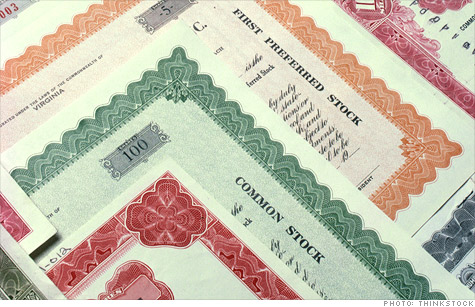Search News

Very little in the world of investments is a true bargain these days, but you can still find pockets of good value in stocks and bonds.
(Money Magazine) -- It's getting tough to find a bargain these days and the stock market isn't cheap. But there's value to be found in the markets, if you tilt your game plan toward equities.
To assess the relative value of stocks and bonds, experts look at the earnings yield on stocks (that is, earnings per share divided by price) vs. the yield of a 10-year Treasury; when that gap is wide, stocks are the better deal.
Today's 7.5 percentage point spread is historically very high, says Alec Young, global equity strategist at S&P Capital IQ. "That's telling you stocks are definitely the better long-term value," he says.
If your portfolio has gotten a bit bond-heavy over the past few years, shift some money back into stocks.
Go big. Really big. Some of the best values right now are the largest companies, typically with stock market values north of $100 billion.
According to the Leuthold Group, the 50 largest multinationals trade at a price/earnings multiple (based on 2012 profit estimates) of 11.6.
That's well below the 15.6 average P/E for the next 2,000 largest stocks.
"You can buy world-class companies in this group at Wal-Mart prices," says George Sertl, a co-manager of Artisan Value fund.
His picks:
Apple (AAPL, Fortune 500) P/E: 12.2
Why: Supercharged growth potential and pristine balance sheet.
Oracle (ORCL, Fortune 500) P/E: 11.2
Why: Is the dominant player in its industry; generates lots of cash.
Piggyback on corporate spending. Some of the best deals today are within the industrials sector, says Brad Sorensen, director of market and sector analysis at the Schwab Center for Financial Research.
Cash-rich companies will increase their spending on equipment and systems as the economy strengthens, and some of their stocks are still well-priced.
Morningstar analyst Adam Fleck points to these two:
Parker Hannifin (PH, Fortune 500) P/E: 10.9
Why: This industrials equipment manufacturer should see a bump in business; smart operating practices have kept its margins fat.
Terex (TEX, Fortune 500) P/E: 8.2
Why: Orders for aerial work platforms and cranes are picking up for this industrial equipment maker; the stock is cheap.
Go abroad for dividends. The equity market has been on a tear this year, yet stocks that don't pay out dividends have enjoyed the lion's share of those gains.
S&P Capital IQ's Alec Young expects returns for the rest of the year to come from dividend income. And he notes that yields abroad are significantly higher.
According to WisdomTree, three-quarters of 2011's payouts came from overseas firms.
Add a bit of junk. Rising Treasury yields recently beat down bond returns, but high-yield bonds are less sensitive to higher rates.
And while a slowing economy is kryptonite for junk, that possibility is looking less likely lately, says Anthony Valeri, investment strategist at LPL Financial. While non-investment-grade bonds have had a sizable rally from this past fall, "the 7% average yield is still compelling vs. what you can get anywhere else," says Valeri.
That said, junk is best sipped, not gulped: Limit your high-yield tasting to 10% or less of your bond portfolio.
What you don't know. The worst one-year return on Treasuries: -14.9%. In 2009 the yield on long-term Treasury bonds rose from 3.5% to 4.5%. While rising yields provide more income, the price of bonds falls when yields increase.
So not a deal. Utilities and REITs.
Sure, dividend yields of 4% or so are enticing, but many utilities are expensive, and as the economy gains steam, defensive stocks will fall further out of favor.
High-yielding real estate trusts, which manage a pool of commercial properties, recently traded at 17 times earnings vs. 13 for the S&P, says Tim Clift, chief investment strategist at Envestnet.
Plus, they'll suffer from higher financing costs when interest rates eventually rise.
Todd Rosenbluth, ETF analyst at S&P Capital IQ picks these best ETF deals.
Vanguard Mega Cap (MGC) "With an annual expense ratio of 0.12% of assets, it's a cheap way to access the largest stocks."
IShares Russell 1000 (IWF) "This gives you exposure to cyclicals. Some 29% of this ETF is tied to IT stocks, 14% in consumer discretionary, and 13% in industrials. Eight of the top 10 largest positions are expected to outperform over the next 12 months."
Wisdomtree DEFA (DWM) "With a 4.2% yield, this international dividend ETF gives you a very diversified approach -- both in sector and in country allocations -- to developed international markets."
SPDR Barclays Capital High Yield Bond (JNK) "Paying a 0.40 expense ratio for a 7% yield is a smart way to get exposure to high-yield bonds."
Do you know a Money Hero? MONEY magazine is celebrating people, both famous and unsung, who have done extraordinary work to improve others' financial well-being. Nominate your Money Hero. ![]()

Carlos Rodriguez is trying to rid himself of $15,000 in credit card debt, while paying his mortgage and saving for his son's college education.
| Overnight Avg Rate | Latest | Change | Last Week |
|---|---|---|---|
| 30 yr fixed | 3.80% | 3.88% | |
| 15 yr fixed | 3.20% | 3.23% | |
| 5/1 ARM | 3.84% | 3.88% | |
| 30 yr refi | 3.82% | 3.93% | |
| 15 yr refi | 3.20% | 3.23% |
Today's featured rates: